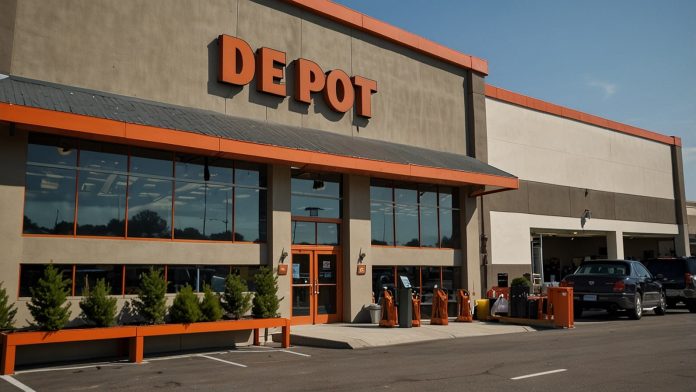Home Depot Inc. announced better-than-anticipated second-quarter profits on August 19, 2025, that will provide renewed optimism to the retail sector that people will continue to invest in home improvement despite the current economic stresses. Having traded down at 4.8 per cent, its price shot up in early trading to approach the 415 mark to be one of the largest home improvement retailers in the world.
This is because shares of the company have been on the rise as investors celebrate the firm, which has learned to counteract the high interest rates, tariff effects and changes in consumer behaviours, making the company a strong player in the mercurial market.
After posting a better-than-expected 13 per cent earnings gain, Wall Street eagerly awaits the earnings release report, which indicates that Home Depot has adopted a strategy of taking on small jobs and focusing on professional customers, thereby countering any weakness in the big-ticket renovations. The analysts had been on the lookout to see the line of impact, how high mortgage rates and inflation were impacting on the discretionary spending. Still, the outcome indicates that the consumers are regrouping and spending on the necessary upgrades.
Financial Highlights
In the fiscal second-quarter report, Home Depot reported earnings per share of 4.72 covering up to July 2025, which is higher than the consensus target of 4.70. Sales increased by 5.2 per cent against the previous year to US $ 45.42 billion, higher than expectations of US $ 45.37 billion and the highest top-line growth of the company in more than a year.
One of the most critical metrics, comparable sales, which excludes the sales growth due to new stores opening, increased by 1.5 per cent across the world, and by 1.8 per cent in the United States. This ended a quarter of stagnant or negative comps over the past few quarters and was underpinned by growing demand in seasonal products, such as outdoor power equipment and garden products.
Chief Executive Officer Ted Decker credited the company’s success to its diverse supply chain and the discipline with which it prices its products. During a conference call with investors, Decker cited that the tariff on imported items has increased a cost but that Home Depot has eliminated a large portion of that costs via efficiencies and supplier discussions meaning that the company has not had to raise prices across the board. This strategy, he argued, has enabled the retailer to attract market share at the expense of a competitor who has incorporated increased costs on the customers.
The Watershed Moon Reaction and the Analyst’s Impressions
After the announcement, shares of Home Depot soared upward in pre-market trading as investors hoped that the entire home market would regain its strength. At lunchtime, the shares had gained 4.3 per cent, giving the company a market value of about $18 billion – and a rise much stronger than the S&P 500, which rose 0.5 per cent on the day. The level of trading went as high as 2.5x average, showing good institutional interest.
Wall Street analysts viewed the action positively, with various firms increasing the price targets. Piper Sandler maintained its buy rating, increasing its target from $ 408 to $ 430, in light of improved housing affordability and indications of interest rate stabilisation. Truist Securities followed along, raised its price objective to 445 and highlighted Home Depot’s advantage in the pro category with increased sales to contractors and builders of 7 per cent. There is still some caution, however; Evercore ISI cautioned that tariff uncertainties might continue to exert pressure on margins as trade tensions intensify any further.
The performance also boosted the counterparts in the industry. Direct competitors such as Lowe Companies saw their stocks increase by 2.l per cent whereas their suppliers such as Stanley Black and Decker increased by 1.8 per cent. The ripple effect aided higher market benchmarks as Home Depot’s results allayed fears over consumer frailty, as the July retail sales figures were impressive.
Prospects and Problems of the Future
Moving forward, Home Depot maintained its full-year outlook with estimates of overall sales growth of roughly 2.8 percent and the growth comps now at 1 percent. The company anticipates that its adjusted earnings per share would be down nearly 2 percent to $15.24 per share last year as the company continues to invest in e-commerce and supply chain improvement. Decker noted that it has ambitions to grow its professional business with acquisitions such as SRS Distribution to attract a larger portion of the $950 billion market that is fragmented in building supplies.
When the report is positive, obstacles shadow. The housing market remains frozen by high mortgage rates, putting major remodels on hold. However, the potential Federal Reserve rate drop in September will serve as a tailwind. Moreover, as President Trump’s tariff policies are subject to change, Home Depot is closely monitoring global trade processes. The firm has also diversified its sources outside of China to decrease its exposure, and its officials admitted that the problem with supply chain could be a long-term issue, resulting in cost impact on inventory.
On the whole, Home Depot shows resilience in the adverse conditions, with its quarter being a positive indication of retail and housing stocks. With the consumers slowly adapting to the new normal in the economy, the retailer is in a good position to take advantage of the pent-up demand in home improvement. Further evidence of a reversal in the sector is likely to be sought in the following report of no remedial action data on housing starts and making permits, which is being released today. At a forward price-to-earnings ratio of 24 (shares are up 3.3 per cent so far this year), Home Depot is a portfolio staple among investors who believe that Americans will always love their DIY projects and home renovations.



 Bitcoin
Bitcoin  Ethereum
Ethereum  Tether
Tether  XRP
XRP  Solana
Solana  USDC
USDC  Lido Staked Ether
Lido Staked Ether  TRON
TRON  Cardano
Cardano  Avalanche
Avalanche  Toncoin
Toncoin